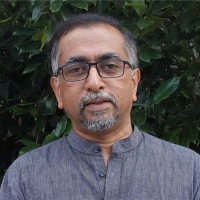Pentecostals and Padamonnai songs with special reference to ' Avan namme nayicheedumbol'
Central Travancore Pentecostals are very much ‘institutionalized’ in nature due to their ‘western spirituality’ through certain ‘traditions’ and ‘rituals’. Even though the majority of the Pentecostals are from dalit community, still the rhythm and style of songs are very much market centred, other worldly / heaven oriented and highly material in nature (e.g. ‘Ente daivathal ente daivathal’). These types of songs (‘pallippatukal’) are so familiar in all churches including Pentecostals. From the period, 1995 to 2000, there was a change in attitude due to theological dialogues from other corners and Senate of Serampore education. (In a recent development 2019 PYPA, IPC Youth organization State camp enjoyed the song ‘Pattum parunthakkettum’ with a good criticism). Three songs from SCM - Padamonnai became familiar among the evangelical circles such as: (1) Avan Namme Nayichidumbol by Santhosh George; (2) Kaniverum Sneha Pithave by Rev Sajan P Mathew (3) Sathyathinte Pathayil by Mammen Varghese Thittamel. The last two songs became familiar through Maramon convention cassettes and the first one due to various other reasons.
Avan Namme Nayichidumbol is one of my favourites from Padamonnai collections. For the first time I heard this song from Sam Philip sir when I was sitting behind Marthoma college chapel, Thiruvalla. Later there were many opportunities to get into the real meaning and context of the song. My ennamma Bhavanam days, reminds me of the theological discussions on Padamonnai songs after evening prayer. Even today we as family sing and discuss the serious questions from the song. I was attracted to this song due to three specialities such as: Style, Rhythm, Theological narration and Zbove all the serious questions it raises about our real commitment and mission.
Style and language: The style and language of the song was very close to common people.There was a particular form of ‘cultural assimilation’ in Kerala SCM, which always denote certain people as lower in ‘SCM spiritual hierarchy’ and they can seek upward mobility by using the typical ‘SCM language’ and by following the practices of the upper group. Most of the songs of that time (kindly excuse Janakiya ganangal) in SCM were partially promoted the so-called hierarchical sanskritization of this SCM spirituality. May be as a matter of contextualized experiments, that style and language became part of the songs like any other art forms and literature. But this song is filled with scriptural symbols with a personal touch. Simple and direct language is the highlight of this song. I was attracted to those biblical imageries and heart touching simple language with serious questions about our testimony and commitment.
Style of Narration: Even though the song communicates communitarian values for a better society, the song is not denying the personal role which call for the immediate response from our side. Any kind of narration in any art form corresponds to a very deep need in our personal level. The style of narration of the song is so familiar among the Pentecostals and other charismatic groups. A ‘cyclic style narration’ is very much visible in this song. This clearly presented the picture of biblical imageries and initiated a conversation which is very much individualistic in nature. Pentecostal reading of this song is very much individualistic in nature due to western theological orientation. Majority of the Pentecostals are not aware of the structural sin/societal sin. So, they took the lines ‘Chaver bhadarai odungeedan’ as dying for Christ by spreading the gospel. Even today the song is used to challenge youngsters as part of altar call in youth camps. I hope in near future a serious reading and response towards this song may take place when we face the real questions about
resources and kingdom values.
Style of Rhythm: The rhythm of this song is very much close to nature and so it automatically influenced the common people. The song filled with a rhythm of life, like the small waves in the paddy fields. The song goes in a typical rhythm which is very common among the working communities. The traditional ‘dalit chanting and pattu (in any special occasion this happened in olden days) uses somewhat similar rhythms and that is very much visible in this song.
Sabu Mathew, YCLT, Yavatmal, Maharashtra.
12 July 2021
Original Background score: Babu Jose
Reprogramming: Anil BS, ABS Audio Inn, Thiruvananthapuram
Video Recording: Anto Santhosh & Joel Jogy
Visual concept, video editing and colour grading: Jeevan K Babu
Studio: Paattupetti Recording Studio, Chengannur

